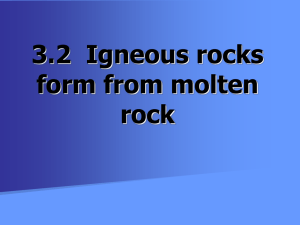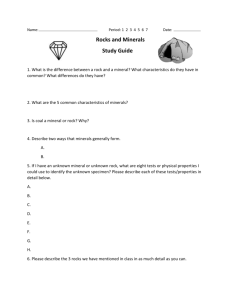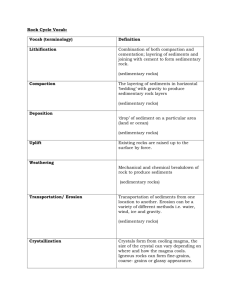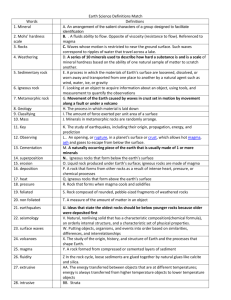File - Science with Ms. Flythe
advertisement
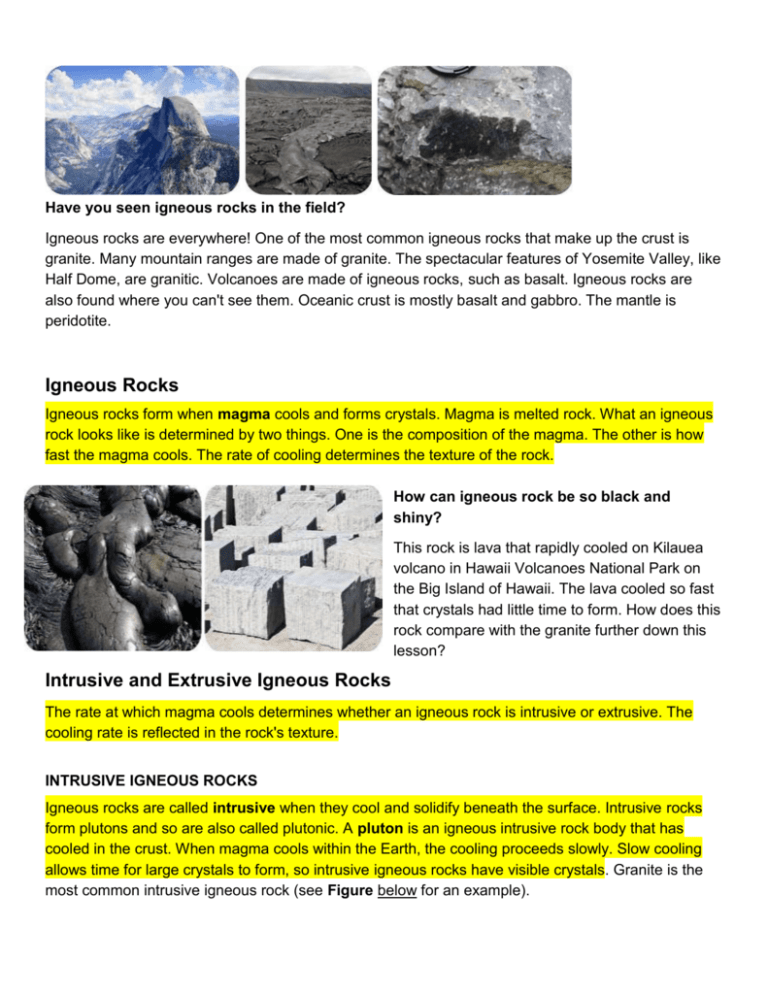
Have you seen igneous rocks in the field? Igneous rocks are everywhere! One of the most common igneous rocks that make up the crust is granite. Many mountain ranges are made of granite. The spectacular features of Yosemite Valley, like Half Dome, are granitic. Volcanoes are made of igneous rocks, such as basalt. Igneous rocks are also found where you can't see them. Oceanic crust is mostly basalt and gabbro. The mantle is peridotite. Igneous Rocks Igneous rocks form when magma cools and forms crystals. Magma is melted rock. What an igneous rock looks like is determined by two things. One is the composition of the magma. The other is how fast the magma cools. The rate of cooling determines the texture of the rock. How can igneous rock be so black and shiny? This rock is lava that rapidly cooled on Kilauea volcano in Hawaii Volcanoes National Park on the Big Island of Hawaii. The lava cooled so fast that crystals had little time to form. How does this rock compare with the granite further down this lesson? Intrusive and Extrusive Igneous Rocks The rate at which magma cools determines whether an igneous rock is intrusive or extrusive. The cooling rate is reflected in the rock's texture. INTRUSIVE IGNEOUS ROCKS Igneous rocks are called intrusive when they cool and solidify beneath the surface. Intrusive rocks form plutons and so are also called plutonic. A pluton is an igneous intrusive rock body that has cooled in the crust. When magma cools within the Earth, the cooling proceeds slowly. Slow cooling allows time for large crystals to form, so intrusive igneous rocks have visible crystals. Granite is the most common intrusive igneous rock (see Figure below for an example). Granite is made of four minerals, all visible to the naked eye: feldspar (white), quartz (translucent), hornblende (black), and biotite (black, platy). Igneous rocks make up most of the rocks on Earth. Most igneous rocks are buried below the surface and covered with sedimentary rock, or are buried beneath the ocean water. In some places, geological processes have brought igneous rocks to the surface. Figure (left) shows a landscape in California’s Sierra Nevada made of granite that has been raised to create mountains. California’s Sierra Nevada is intrusive igneous rock exposed at Earth’s surface. EXTRUSIVE IGNEOUS ROCKS Igneous rocks are called extrusive when they cool and solidify above the surface. These rocks usually form from a volcano, so they are also called volcanic rocks (Figure right). Extrusive igneous rocks form after lava cools above the surface. Extrusive igneous rocks cool much more rapidly than intrusive rocks. There is little time for crystals to form, so extrusive igneous rocks have tiny crystals (Figure right). Cooled lava forms basalt with no visible crystals. Why are there no visible crystals? Different cooling rate and gas content resulted in these different textures. Use of igneous rocks Many igneous rocks are hard, dense, and durable. People throughout history have used igneous rock for tools and building materials. Granite has a long history as a building material. Ancient Egyptians used granite for statues. In the United States in the 1800s and early 1900s, granite was widely used to build bridges and public buildings and for paving streets with cobblestones. Granite is still used in decorative stonework, curbstones, and floors, Basalt is crushed to make gravel that is used in construction. The rough surface of pumice makes it a good abrasive for cleaning and polishing. Obsidian was used by ancient native Americans to make sharp tools. Perlite, formed from the heating of obsidian, is often mixed with soil for starting vegetable seeds. What is this material and what created the ripples? If you've walked on a sandy beach or on a sand dune, you may have seen ripples like this formed from wind or waves. Sand is small broken pieces of rock that can be moved around. They can also be lithified to become a rock known as sandstone. Sediments Sandstone is one of the common types of sedimentary rocks that form from sediments. There are many other types. Sediments may include: Fragments of other rocks that often have been worn down into small pieces, such as sand, silt, or clay. Organic materials or the remains of once-living organisms. Chemical precipitates, which are materials that get left behind after the water evaporates from a solution. Rocks at the surface undergo mechanical and chemical weathering. These physical and chemical processes break rock into smaller pieces. Mechanical weathering simply breaks the rocks apart. Chemical weathering dissolves the less stable minerals. These original elements of the minerals end up in solution and new minerals may form. Sediments are removed and transported by water, wind, ice, or gravity in a process called erosion (Figure right). Much more information about weathering and erosion can be found in Concept Surface Processes and Landforms. Water erodes the land surface in Alaska’s Valley of Ten Thousand Smokes Streams carry huge amounts of sediment (Figure left). The more energy the water has, the larger the particle it can carry. A rushing river on a steep slope might be able to carry boulders. As this stream slows down, it no longer has the energy to carry large sediments and will drop them. A slower moving stream will only carry smaller particles. A river dumps sediments along its bed and on its banks. Sediments are deposited on beaches and deserts, at the bottom of oceans, and in lakes, ponds, rivers, marshes, and swamps. Landslides drop large piles of sediment. Glaciers leave large piles of sediments, too. Wind can only transport sand and smaller particles. The type of sediment that is deposited will determine the type of sedimentary rock that can form. Different colors of sedimentary rock are determined by the environment where they are deposited. Red rocks form where oxygen is present. Darker sediments form when the environment is oxygen poor. Summary Rocks undergo chemical or mechanical weathering to form smaller pieces. Sediments range in size from tiny bits of silt or clay to enormous boulders. Sediments are transported by wind, water, ice, or gravity into different environments. What steps led to this rock formation? What do you see? The rock is sandstone, so first there were rocks that weathered and eroded. The cross-bedding indicates that the sand was deposited in a dune. The sand was then buried deeply enough that it turned into rock. This lesson will explore how something like sand could become a rock. Sedimentary Rock Formation Erosion occurs when running water, wind, or ice loosens and carry away fragments of rock. Eventually, the moving water, wind, or ice slows and deposits the sediment in layers. Deposition is the process by which sediment settles out of the water or wind carrying it. The process that presses sediments together is compaction. Over millions of years, thick layers of sediment build up. These heavy layers press down on the layers beneath them. While compaction is taking place, the minerals in the rock slowly dissolve in the water. Cementation is the process in which dissolved minerals crystallize and glue particles of sediment together. This cliff is made of sandstone. Sands were deposited and then cemented. Use of sedimentary rocks People have used sedimentary rocks through history for many different purposes, including building materials and tools. Sandstone and limestone have been used as building materials because they are soft enough to be cut easily into blocks or slabs. Limestone is used in making cement. Can you decipher the history of this rock? The rock in this photo is banded gneiss. The bands are of different composition, more felsic and more mafic, that separated as a result of heat and pressure. The waviness of the bands also shows how the rock was hot enough to alter but not to melt all the way. Metamorphism Any type of rock – igneous, sedimentary, or metamorphic — can become a metamorphic rock. All that is needed is enough heat and/or pressure to alter the existing rock’s physical or chemical makeup without melting the rock entirely. Rocks change during metamorphism because the minerals need to be stable under the new temperature and pressure conditions. The need for stability may cause the structure of minerals to rearrange and form new minerals. Ions may move between minerals to create minerals of different chemical composition. A foliated metamorphic rock. Use of Metamorphic Rock Certain metamorphic rocks are important materials for building and sculpture. Marble and slate are two of the most useful metamorphic rocks. Marble can be cut into thin slabs, and it can be polished so that its surface is smooth and mirror-like. These qualities have led architects and sculptors to use marble for many buildings and statues. For example, one of America’s most famous sculptures is in the Lincoln Memorial in Washington, D.C. Like marble, slate comes in a variety of colors, including gray, black, red, and purple. Slate, because it is foliated, splits easily into flat pieces that can be used for flooring, roofing, outdoor walkways, or chalkboards. Is this what geologists mean by the rock cycle? Okay, very punny. The rock cycle shows how any type of rock can become any other type of rock. Some rocks may stay the same type for a long time, for example, if they're at the base of the crust, but other rocks may relatively rapidly change from one type to another. The Rock Cycle The rock cycle, illustrated in Figure below, depicts how the three major rock types – igneous, sedimentary, and metamorphic - convert from one to another. Arrows connecting the rock types represent the processes that accomplish these changes. Rocks change as a result of natural processes that are taking place all the time. Most changes happen very slowly. Rocks deep within the Earth are right now becoming other types of rocks. Rocks at the surface are lying in place before they are next exposed to a process that will change them. Even at the surface, we may not notice the changes. The rock cycle has no beginning or end. The Rock Cycle. The Three Rock Types Rocks are classified into three major groups according to how they form. These three types will be described in more detail in other lessons in this concept, but here is an introduction. Igneous rocks form from the cooling and hardening of molten magma in many different environments. The chemical composition of the magma and the rate at which it cools determine what rock forms. Igneous rocks can cool slowly beneath the surface or rapidly at the surface. These rocks are identified by their composition and texture. More than 700 different types of igneous rocks are known. Sedimentary rocks form by the compaction and cementing together of sediments, broken pieces of rock-like gravel, sand, silt, or clay. Those sediments can be formed from the weathering and erosion of preexisting rocks. Sedimentary rocks also include chemical precipitates, the solid materials left behind after a liquid evaporates. Metamorphic rocks form when the minerals in an existing rock are changed by heat or pressure below the surface. The Processes of the Rock Cycle Several processes can turn one type of rock into another type of rock. The key processes of the rock cycle are crystallization, erosion and sedimentation, and metamorphism. CRYSTALLIZATION Magma cools either underground or on the surface and hardens into an igneous rock. As the magma cools, different crystals form at different temperatures, undergoing crystallization. For example, the mineral olivine crystallizes out of magma at much higher temperatures than quartz. The rate of cooling determines how much time the crystals will have to form. Slow cooling produces larger crystals. EROSION AND SEDIMENTATION Weathering wears rocks at the Earth’s surface down into smaller pieces. The small fragments are called sediments. Running water, ice, and gravity all transport these sediments from one place to another by erosion. During sedimentation, the sediments are laid down or deposited. In order to form a sedimentary rock, the accumulated sediment must become compacted and cemented together. METAMORPHISM When a rock is exposed to extreme heat and pressure within the Earth but does not melt, the rock becomes metamorphosed. Metamorphism may change the mineral composition and the texture of the rock. For that reason, a metamorphic rock may have a new mineral composition and/or texture. Summary The three main rock types are igneous, metamorphic and sedimentary. The three processes that change one rock to another are crystallization, metamorphism, and erosion and sedimentation. Any rock can transform into any other rock by passing through one or more of these processes. This creates the rock cycle.



